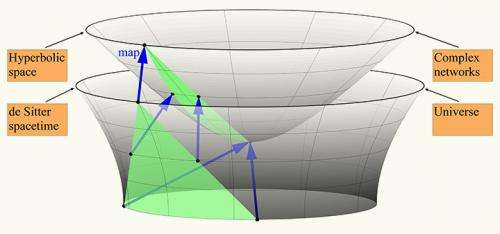Human brain, internet, and cosmology: Similar laws at work?

(Phys.org)—The structure of the universe and the laws that govern its growth may be more similar than previously thought to the structure and growth of the human brain and other complex networks, such as the Internet or a social network of trust relationships between people, according to a new paper published in the science journal Nature's Scientific Reports.
"By no means do we claim that the universe is a global brain or a computer," said Dmitri Krioukov, co-author of the paper, published by the Cooperative Association for Internet Data Analysis (CAIDA), based at the San Diego Supercomputer Center (SDSC) at the University of California, San Diego. "But the discovered equivalence between the growth of the universe and complex networks strongly suggests that unexpectedly similar laws govern the dynamics of these very different complex systems."
Having the ability to predict – let alone trying to control – the dynamics of complex networks remains a central challenge throughout network science. Structural and dynamical similarities among different real networks suggest that some universal laws might be in action, although the nature and common origin of such laws remain elusive.
By performing complex supercomputer simulations of the universe and using a variety of other calculations, researchers have now proven that the causal network representing the large-scale structure of space and time in our accelerating universe is a graph that shows remarkable similarity to many complex networks such as the Internet, social, or even biological networks.
"These findings have key implications for both network science and cosmology," noted Krioukov. "We discovered that the large-scale growth dynamics of complex networks and causal networks are asymptotically (at large times) the same, explaining the structural similarity between these networks."
"This is a perfect example of interdisciplinary research combining math, physics, and computer science in totally unexpected ways," said SDSC Director Michael Norman. "Who would have guessed that the emergence of our universe's four-dimensional spacetime from the quantum vacuum would have anything to do with the growth of the Internet? Causality is at the heart of both, so perhaps the similarity Krioukov and his collaborators found is to be expected."
Of course the network representing the structure of the universe is astronomically huge – in fact it can be infinite. But even if it is finite, researchers' best guess is that it is no smaller than 10250 atoms of space and time. (That's the digit 1 followed by 250 zeros.) For comparison, the number of water molecules in all the oceans in the world has been estimated to be 4.4 x 1046.
Yet the researchers found a way to downscale this humongous network while preserving its vital properties, by proving mathematically that these properties do not depend on the network size in a certain range of parameters, such as the curvature and age of our universe.
After the downscaling, the research team turned to Trestles, one of SDSC's data-intensive supercomputers, to perform simulations of the universe's growing causal network. By parallelizing and optimizing the application, Robert Sinkovits, a computational scientist with SDSC, was able to complete in just over one day a computation that was originally projected to require three to four years.
"In addition to being able to complete these simulations much faster than previously ever imagined, the results perfectly matched the theoretical predictions of the researchers," said Sinkovits.
"The most frequent question that people may ask is whether the discovered asymptotic equivalence between complex networks and the universe could be a coincidence," said Krioukov. "Of course it could be, but the probability of such a coincidence is extremely low. Coincidences in physics are extremely rare, and almost never happen. There is always an explanation, which may be not immediately obvious."
"Such an explanation could one day lead to a discovery of common fundamental laws whose two different consequences or limiting regimes are the laws of gravity (Einstein's equations in general relativity) describing the dynamics of the universe, and some yet-unknown equations describing the dynamics of complex networks," added Marián Boguñá, a member of the research team from the Departament de Física Fonamental at the Universitat de Barcelona, Spain.
More information: www.nature.com/srep/2012/12111 … /full/srep00793.html
Journal information: Scientific Reports
Provided by University of California - San Diego




















